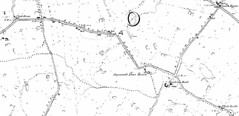


About the images.....all 3 areas of Harlton (Hurleston), Aspinwall (Asmall) and Litherland lie between Scarisbrick, Ormskirk & Halsall - the source of the information about early Aykescogh. Taken from a copy of the 1847 Ordnance Survey map of Scarisbrick and district (provided by A. Scarisbrick), which shows Hurleston under the old spelling of 'Harlton', and Asmall under the old spelling of 'Aspinwall', right at the bottom of this map is an area called 'Litherland', which was also in the district in the 1800's.
Information researched by Jonathon Hopper:
"These, and the Ormskirk priests contributors list - imply Ayscough is a place....in Harleton... near Litherland, Aspinwall... a wood......
HARLETON
HARLETON (fn. 85) was held of the lords of Scarisbrick by a family whose surname was derived from it; the tenure was homage and fealty and the yearly service of 4s. (fn. 86) The first mention of the place after Domesday book is a charter of about the year 1190 by which Robert, son of Ulf de Hurleton, gave to the abbey of Cockersand 2 acres of his land in Harleton. (fn. 87) He afterwards granted to Burscough Priory land near Ayscough in Harleton, in pure alms, for the souls of King John, his own father and mother, and others. (fn. 88)
Before 1233 Robert had been succeeded by his son Roger. (fn. 89) Roger was a benefactor to Burscough, granting land in the townfield of Harleton, (fn. 90) also the lands on the east of Nather dale, 'from Simon's barn to the Graynet hake,' and elsewhere in Harleton. (fn. 91) Several of his charters are preserved at Scarisbrick, including one to his brother Richard. (fn. 92) In 1246 he was summoned to warrant to the abbot of Cockersand 48 acres, which the latter held of him by the charter of Robert his father; Walter de Scarisbrick was claiming certain land in Naithalargh as inherited from his father Gilbert. (fn. 93) Roger was himself a benefactor to Cockersand. (fn. 94) He took part in 1261 in the agreement as to boundaries made with the prior of Burscough, and in 1303 Robert, his son and successor, joined in a further agreement. (fn. 95)
For several generations the lords of Harleton bore the name of Robert, so that it is impossible to distinguish them clearly. (fn. 96) In 1365 there occurred a dispute as to the wardship of Robert, son and heir of Robert de Hurleton, ten years of age; Henry de Scarisbrick claimed as the immediate lord of Harleton, while Sir William de Atherton claimed as representing the Lathoms; the former established his right. (fn. 97) In 1369 Robert de Hurleton and Margaret his wife were claiming lands in Harleton from Roger de Shaw and Margery his wife and their son John. (fn. 98)
Ref 91
Ibid. fol. 19b, 18b, 19. The last concerns land 'at the head of Aykescough'; the bounds began at the syke on the west, followed the ditch north to the boundary of Aspinwall,' saving a certain exit where the road leads from Litherland to Harleton;' then by Aspinwall ditch to the corner by the south, and by another ditch to the commencement.
Ref 96
The Scarisbrick deeds include several relating to them. In 1332 William, John, and Nicholas, sons of Robert de Hurleton, resigned to their father a rent of 3s. 4d. issuing from the manor (n. 61). Ten years later Robert son of Robert de Hurleton made various grants on the occasion of his own son Robert's marriage with Eleanor, daughter of Gilbert de Scarisbrick; by the first he gave his son a rent-charge of £20 upon his manors and lands; and by another he gave his part of the wood of Aykescough and lands tenanted by Richard Bonyard and others; while the son agreed that the rent-charge should not be used provided his father made no alienation of the estates (n. 71, 70, 70*). Alice widow of Matthew de Hurleton was a plaintiff in 1317. De Banc. R. 219, m. 151.
From: 'Townships: Scarisbrick', A History of the County of Lancaster: Volume 3 (1907), pp. 265-76. URL: http://www.british-history.ac.uk/report.asp?compid=41332&strquery=Aykescough. Date accessed: 10 April 2007"
and Andrew Scarisbrick is able to shed some light on the areas/ regions mentioned in the passage above:
"Regarding all the place names you have been enquiring about....
Harleton is the old spelling of Hurlston (or Hurleston), an area now within the village of Scarisbrick, but was mentioned in Domesday book, before Scarisbrick had properly come into being. It was centered around Hurlston Hall, which was demolished in the 20th century, due to being in a very dilapidated state. It used to belong to the Hurlston family, but was bought by the Scarisbrick family, and leased out as a farmhouse.
There is now a golf course on the site, and a road called Hurlston Lane, which you should be able to find on streetmap or similar. This is all right by (less than a mile from) where I live.
Aspinwall was another area of land, spanning the borders of Scarisbrick, Halsall and Ormskirk. It is now spelled Asmall, but in the earlier censuses, it is still under the old spelling. Look for Asmall Lane in streetmap. It crosses all three of the above places.
I believe there used to be a place called Litherland in the area, but this has since become lost over time - unrelated to the Litherland of Liverpool.
It did used to be a slightly wooded area, but I was unaware of any place by the name of Ainscough, or Aykescogh, in the area. I shall have to take another look at the Victoria County History again.
Andy"